The topic of this article may not meet Wikipedia's notability guidelines for products and services .(February 2023) |
The .35 Winchester Self-Loading (also called .35SL, .35SLR, or .35WSL) is an American rifle cartridge.
The topic of this article may not meet Wikipedia's notability guidelines for products and services .(February 2023) |
The .35 Winchester Self-Loading (also called .35SL, .35SLR, or .35WSL) is an American rifle cartridge.
Winchester introduced the .32SL and .35SL in the Winchester '05 self-loading rifle as a centerfire cartridge version of the Winchester '03. The .35SL proved popular at first with the general public as a short-range deer and black bear hunting cartridge, but was soon superseded by the introduction of the more powerful .351SL in the Winchester '07. [1]

Many now consider the .35SL inadequate as a deer round, but it may still be suitable for coyote or similar medium-sized game at close ranges. When first introduced however, the notable firearm expert Townsend Whelen noted the .35SL cartridge as displaying similar ballistics as the .38-40 black powder, low-pressure cartridge. [2]


The .32-20 Winchester, also known as .32 WCF , was the first small-game lever-action cartridge that Winchester produced. It was initially introduced as a black-powder cartridge in 1882 for small-game, varmint hunting, and deer. Colt produced a single-action revolver chambered for this cartridge a few years later.
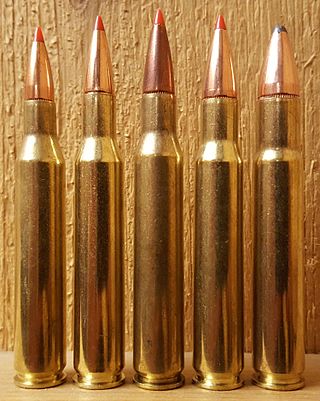
The .270 Winchester is a rifle cartridge developed by Winchester Repeating Arms Company in 1923 and it was unveiled in 1925 as a chambering for their bolt-action Model 54 to become arguably the flattest shooting cartridge of its day, only competing with the .300 Holland & Holland Magnum, also introduced in the same year.
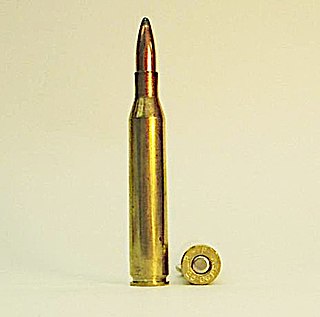
Considered by many as the most balanced of the "quarter bores" for hunting medium-sized game, the .25-06 Remington remained in obscurity as a wildcat cartridge for nearly half a century before being standardized by Remington in 1969.

The 9.3×62mm is a rimless, bottlenecked rifle cartridge designed in 1905 by German gunmaker Otto Bock. It is suitable for hunting medium to large game animals in Africa, Asia, Europe, and North America. At a typical velocity of 720 m/s, its 286 gr standard load balances recoil and power for effective use at 250m to 300m. The C.I.P. Maximum Average Pressure (MAP) for the 9.3×62mm is 390.00 MPa (56,565 psi).
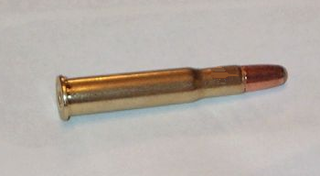
The .30-30 Winchester cartridge was first marketed for the Winchester Model 1894 lever-action rifle in 1895. The .30-30, as it is most commonly known, along with the .25-35 Winchester were offered that year as the United States' first small-bore sporting rifle cartridges designed for smokeless powder. Since its introduction, it has been surpassed by many cartridges in the long-range shooting attributes of speed, energy, and trajectory, yet remains in widespread use because of its practical effectiveness in forested hunting situations.
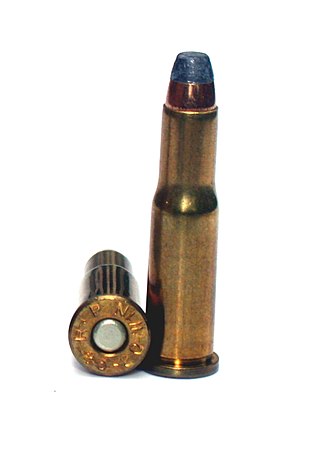
The .25-20 Winchester, or WCF, was developed around 1895 for the Winchester Model 1892 lever action rifle. It was based on necking down the .32-20 Winchester. In the early 20th century, it was a popular small game and varmint round, developing around 1,460 ft/s with 86-grain bullets. But two years earlier Marlin Firearms Co. had already necked down the .32-20 Winchester, and called it the .25-20 Marlin. It was first chambered in Model 1889 lever action Marlins long before Winchester did the same thing and put their name on the .25-20.

The .25-35 Winchester Center Fire was introduced in 1895 by Winchester for the Winchester Model 1894. Together with the .30-30 Winchester, it was one of the earliest smokeless cartridges designed in North America for a sporting rifle. Savage adopted it for its Savage Model 99 lever-action rifles. The case was based on the .30-30 cartridge.

The .35 Whelen is a powerful medium-bore rifle cartridge that does not require a magnum action or a magnum bolt-face. The parent of this cartridge is the .30-06 Springfield, which is necked-up to accept a bullet diameter of .358 in (9.1 mm). This cartridge is more powerful than its parent, especially in killing power on large game. However, with much wider availability, and the higher BC .30 caliber bullets of today, the power gap between the two cartridges has been decreased.

The .338-06 is a cartridge based on the .30-06. It allows heavier .338 caliber bullets to be used from the .30-06 non-belted case. This can be a suitable choice for heavy bodied game such as moose, elk, and brown bear. The number and variety of .338 caliber bullets increased after the introduction in the late 1950s of the .338 Winchester Magnum cartridge, frequently chambered in the Winchester Model 70 rifle. More recently the introduction of the .338 Lapua magnum has caused an increase in interest in the .338 caliber and their projectiles. The .338-06 maintains much of the benefits of the .338 Winchester Magnum cartridge but has substantially less recoil, makes more efficient use of powder, and allows use of widely available .30-06 commercial and military cases. It is similar in concept to the .333 OKH as well as the .35 Whelen, which also use the .30-06 brass case as a basis for the cartridge. Thanks to the large number of rifles based on the .30-06 family of cartridges, having a .338-06 made usually only requires a simple barrel change by a competent gun smith. A-Square adopted the caliber as the .338-06 A-Square in approximately 1998, and was approved by SAAMI as a standardized caliber. Weatherby offered factory rifles and ammunition, but has now dropped the rifles from its inventory. The .338-06 A-Square tends to have a velocity advantage over the .35 Whelen and uses bullets that retain velocity and resist wind drift better than similar weight bullets fired from the .35 Whelen.
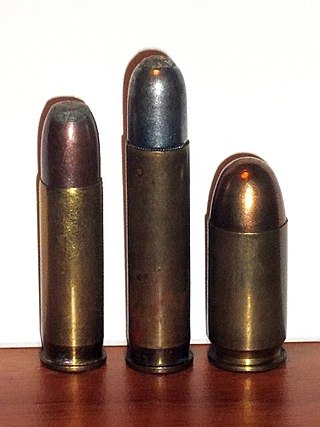
The .351 Winchester Self-Loading is an American rifle cartridge designed in 1906.
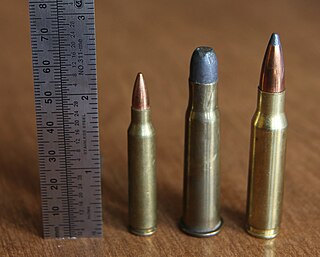
The .33 Winchester Center Fire is a centerfire rifle cartridge designed and produced from 1902 to 1940 by Winchester Repeating Arms Company for their Model 1886 lever-action rifle.
The .32 Winchester Self-Loading is an American rifle cartridge.

The .401 Winchester Self-Loading is an American rifle cartridge.
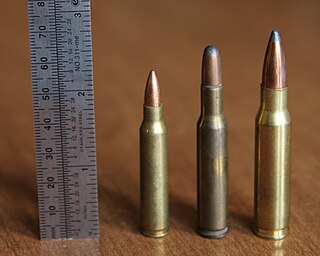
The .25 Remington is an American rifle cartridge. A rimless, smokeless powder design, this cartridge was considered to be very accurate by period firearm experts and suitable for game up to deer and black bear. It was based on the .30 Remington cartridge.

The .32 Remington is an American rifle cartridge. A rimless, smokeless powder design, this cartridge was once considered to be suitable for game larger than deer and black bear. Similar contemporary cartridges include the rimmed .32 Winchester Special, a cartridge introduced by Winchester and offered as a chambering in Winchester's lever-action rifles.
The .38-72 Winchester, also known as .38-72 WCF is a rimmed, bottleneck centerfire rifle cartridge introduced in 1895 for the Winchester 1895 lever-action rifle.

The .40-72 Winchester, also known as .40-72 WCF is a centerfire straight-walled rifle cartridge designed for black powder rather than smokeless powder. It was introduced in 1895 for the Winchester 1895 lever-action rifle.

Major Ned H. Roberts, was an American hunter, competition target shooter, gun writer & editor, ballistician and firearms experimenter. Roberts was a prolific contributor to sporting publications, including Outdoor Life, Outers, Arms and the Man (later renamed as American Rifleman, and to Hunting and Fishing magazine, for which latter publication he served as Firearms Editor. His work on cartridge design in collaboration with Adolph Otto Niedner, Franklin Weston Mann, Townsend Whelen, and F.J. Sage led to a commercialized version of his own original .25-caliber wildcat cartridge introduced by Remington in 1934 and named the .257 Roberts.
The .345 Winchester Self-Loading is a rimless, rifle fire cartridge in a "cylindrical" shape, created in 1917 by the Winchester Repeating Arms Company.
The .360 Buckhammer, also called 360 BHMR (9.1×46mmR), is a SAAMI-standardized straight-walled intermediate rifle cartridge developed by Remington Arms Company. The cartridge was designed for use in American states that have specific regulations for deer hunting with straight-walled centerfire cartridges.